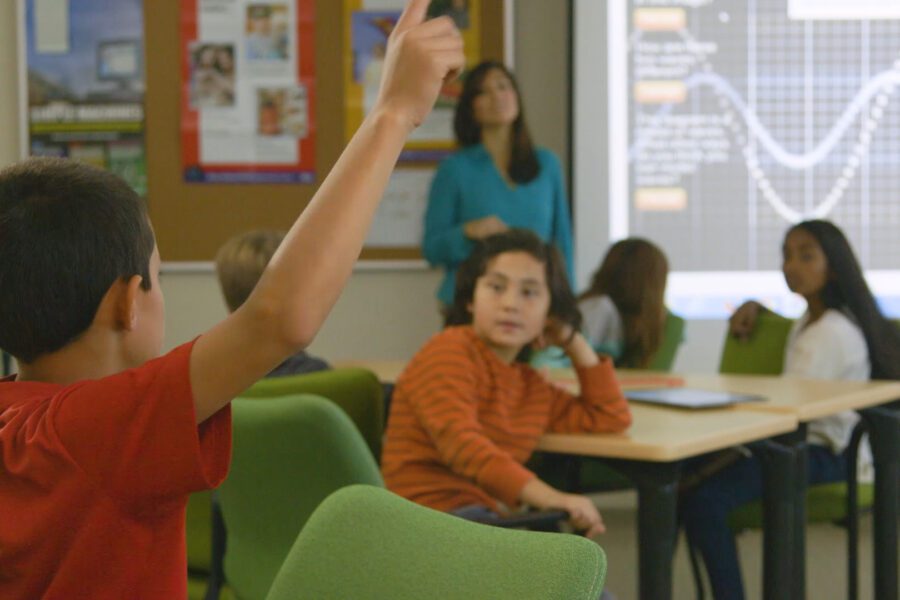
Many industries needed to make serious adjustments to account for the tumultuous waves of the COVID-19 pandemic, and the educational space was no different.
As the world continues to experience technological and societal shifts, educators will continue to see changes in the classroom. This blog will explore the upcoming trends to be aware of for 2022, from technology to methodologies, for students of all ages.
Technology trends
Education technology (EdTech) will continue to support remote and hybrid learning environments in 2022. According to LearnPlatform’s 2021 EdTech Top 40 survey, districts with over 1,000 students accessed 1,449 education technology products every month during the 2020 to 2021 school year. Over 50% of the technologies accessed were learner-focused.
While teachers and students are both growing burned out by the blanket of technology they’ve been under since March of 2020, the solution is not to ditch it all at once. The key, instead, is to find a sustainable balance that is more intentional and makes sense for the students’ and teachers’ needs.
AI and machine learning
While AI-powered solutions are not necessarily new to academia, the way we will use them will be. AI, instead of replacing teachers, can support educators with daily activities and optimize their task lists. According to a June 2021 The Journal article, AI offers personalization on education platforms, tutoring, and 24/7 access to learning tools that benefit both teachers and students.
AI can best be utilized in the hybrid education model by helping teachers with test-taking analytics. An AI-powered tool, for example, could scan test results on behalf of educators, pointing out where students are struggling most on a subject and even suggest refresher lessons to support them.
Additionally, AI can help improve cybersecurity in numerous ways, from detecting suspicious activity to alerting resources to act on a potential breach.
Cloud technology
Software as a service (SaaS) technology permeated the education world quickly in 2020. From communication platforms to classroom engagement and instruction, software has been able to support students and teachers adjusting to the new EdTech world.
The shift came when teachers realized students didn’t have the infrastructure to hold all of the in-house technology they would normally get in the classroom. Cloud computing allows anyone to access the platforms they need with the correct login credentials without ever needing to download applications or networks.
LearnPlatform noted that Google Suite products like Google Docs and Google Slides were among the top products used. Google Classroom was the top learning management system and Kahoot! was the top classroom engagement and instruction software. These SaaS products made e-learning possible and will continue to not only support but may dictate the future of education.
Life-long learning
While the US is open for travel, many countries like Australia are not, which damages their prospective job applicant pool. Many employers as a result are noticing a skills shortage for available roles. In response, many employees are looking for continued education opportunities to boost their resumes.
Educators have the opportunity to open up their online classrooms for skills-based education for these learners who want to upskill. At the same time, K-12 teachers should prompt their students to foster a self-development mindset. This can help prepare them for a changing professional landscape where upskilling and life-long learning is the norm.
Soft skills training
Soft skills, such as time management, problem-solving and critical thinking, are essential for the success of every individual’s career. Soft skills directly impact a student’s academic achievement, which will likely help them professionally. While teaching these abilities isn’t necessarily new for educators, finding ways to translate these lessons into the classroom in 2022 is. Institutions that can balance screen time with face-to-face student interactions can better foster soft skill development.
Teachers who find a way to educate their students on how to ask for what they need, communicate their thoughts and feelings, be cooperative, and embrace teamwork in ethical ways can set the future generation up for success in their professional roles.
Decreasing attention spans
There are innumerable ways for students to get distracted during class. Signs of a short attention span include difficulty reading long texts, leaving tasks partially completed, making careless mistakes, and poor time management.
Cornell University conducted a study in 2021 to find solutions for teachers to not only track but sustain students’ attention online. They proposed “five distinct non-verbal features to calculate the attention score of the student during computer-based tasks and generate real-time feedback for both students and the organization.”
WebMD suggests that instead of forcing students to focus for longer than is natural, students should take periodic short breaks. Throughout the school year, teachers may even see improvements in their students’ ability to stay dialed into their lessons.
VR immersive learning
Thanks to the capabilities of VR, educators for K-12 are considering utilizing the technology for more immersive learning. As long as students are studying from home or even opting for a permanent remote learning environment, VR technology can help them explore the world as if they were working in person. VR could, for example, offer students virtual field trips or even stimulate a more focused “classroom.”
Immersive technologies invite students into a virtual world where they can interact with teachers and fellow students in real-time as if they were in person. This can help create a sense of community and collaboration that a simple video meeting room wouldn’t otherwise offer.
Specifically, the virtual classroom using VR can also cut down on outside distractions while engaging students with lower attention spans or diagnosed cognitive learning disabilities. It can also address soft skill training otherwise unavailable through video conferencing.
The future of teaching will continue to be technology-focused in a way that makes sense to the learning environment and the students. To learn more about training and support around virtual learning, check out our events and webinars page!


